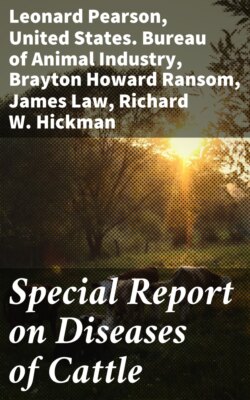Читать книгу Special Report on Diseases of Cattle - Lowe - Страница 33
На сайте Литреса книга снята с продажи.
DEPRAVED APPETITE (PICA).
ОглавлениеCattle suffering from this disease have a capricious and variable appetite as regards their ordinary feed but evince a strong desire to lick and eat substances for which healthy cattle show no inclination. Alkaline and saline-tasting substances are especially attractive to cattle having a depraved appetite and they frequently lick lime, earth, coal, gravel, and even the dung of other cattle. Cows in calf and young cattle are especially liable to develop these symptoms. Animals affected in this way lose condition, their coat is staring, gait slow, and small vesicles containing yellow liquid form under the tongue; the milk given by such cows is thin and watery. Such animals become restless and uneasy, as is indicated by frequent bellowing. The disease may last for months, the animal ultimately dying emaciated and exhausted. Depraved appetite frequently precedes the condition in which the bones of cattle become brittle and fracture easily, which is known as osteomalacia.
Cause.—From the fact that this disease is largely one of regions, it is generally believed that some condition of the soil and water and of the local vegetation is responsible for it. It is more prevalent some years than others, and is most common in old countries, where the soil is more or less depleted. Cattle pastured on low, swampy land become predisposed to it. It occasionally happens, however, that one individual in a herd suffers though all are fed alike; in such cases the disease must arise from the affected animal's imperfect assimilation of the nutritive elements of the feed which is supplied to it.
Treatment.—The aim in such cases must be to improve the process of digestion and to supply the animal with a sufficiency of sound and wholesome feed. The following should be given to the cow three times a day, a heaping tablespoonful constituting a dose: Carbonate of iron, 4 ounces; finely ground bone or "bone flour," 1 pound; powdered gentian, 4 ounces; common salt, 8 ounces; powdered fenugreek, 4 ounces; mix. In addition to this, 3 tablespoonfuls of powdered charcoal may be mixed with the feed three times a day, and a piece of rock salt should be placed where the animal can lick it at will. German veterinarians have had brilliant results from the treatment of this disease with subcutaneous injections of apomorphin in doses of 1½ to 5 grains for three or four days.
